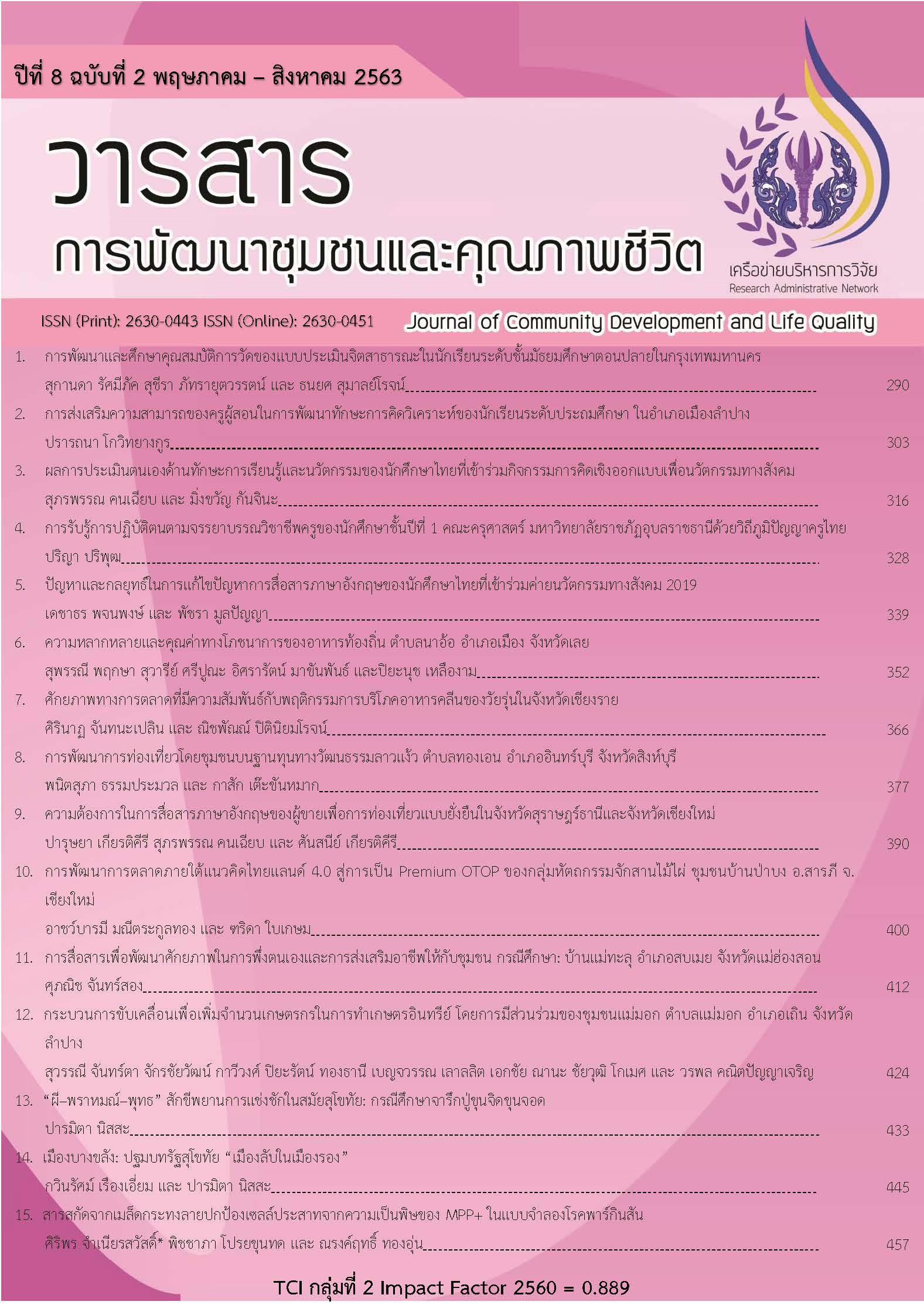ความต้องการในการสื่อสารภาษาอังกฤษของผู้ขายเพื่อการท่องเที่ยวแบบยั่งยืนใน จังหวัดสุราษฎร์ธานีและจังหวัดเชียงใหม่
Main Article Content
บทคัดย่อ
บทความวิจัยนี้วิเคราะห์ความต้องการของประชาชนที่ดำเนินการธุรกิจที่เกี่ยวข้องกับการท่องเที่ยวแบบยั่งยืน การวิจัยนี้เป็นการวิจัยเชิงปริมาณ ศึกษาจากกลุ่มตัวอย่างจำนวน 200 คนได้แก่ประชาชนประชาชนในชุมชนตำบลบางใบไม้ อ.เมือง จ. สุราษฎร์ธานี และประชาชนในชุมชนตำบลแม่คือ อ. ดอยสะเก็ด จ. เชียงใหม่ โดยงานวิจัยนี้ใช้วิธีการเลือกกลุ่มตัวอย่างแบบเจาะจง เครื่องมือที่ใช้ในการวิจัยได้แก่ แบบสอบถามในรูปแบบรายการตรวจสอบและมาตรวัดแบบลิเคิร์ท 5 ระดับเกี่ยวกับปัญหาและสถานการณ์การสื่อสารภาษาอังกฤษกับลูกค้าชาวต่างชาติ ผลการวิจัยพบว่าผู้ขายมีปัญหาในการสื่อสารภาษาอังกฤษกับลูกค้าชาวต่างชาติในระดับสูง โดยเฉพาะปัญหาการพูดมีระดับที่สูงกว่าปัญหาการฟัง นอกจากนี้ผู้ขายมีความต้องการที่จะพัฒนาทักษะภาษาอังกฤษ โดยเฉพาะหัวข้อที่เกี่ยวข้องกับการทักทาย การให้ข้อมูลทั่วไป การซื้อขาย การโฆษณาสินค้า และการต่อรองราคา
Article Details
กองบรรณาธิการขอสงวนสิทธิ์ในการตรวจและแก้ไขบทความที่เสนอเพื่อตีพิมพ์ในวารสารการพัฒนาชุมชนและคุณภาพชีวิต
บทความหรือข้อความคิดเห็นใด ๆ ที่ปรากฏในวารสารการพัฒนาชุมชนและคุณภาพชีวิต เป็นวรรณกรรมของผู้เขียนโดยเฉพาะคณะผู้จัดทำไม่จำเป็นต้องเห็นด้วย และไม่ใช่ความรับผิดชอบของมหาวิทยาลัยและคณะผู้จัดทำ / บรรณาธิการ
References
Debois, S. 2016. 9 Advantages and disadvantages of questionnaires. (Online). Available: https://surveyanyplace.com/questionnaire-pros-and-cons/ (June 16, 2018)
Fahmongkolchai, A. 2011. Needs and problems in English speaking and listening skills of CIMB Thai Bank tellers. (M.A. Thesis), Srinakharinwirot University, Bangkok. 63 p.
Firestone, W. A. 2005. Meaning in method: The rhetoric of quantitative and qualitative research. Educational Researcher 16(7): 16-21.
Gall, J.P., M.D. Gall and W.R. Borg. 2005. Applying Educational Research: A Practical Guide. 5th ed. Pearson, Boston. 570 p.
Khamkhien, A. 2010. Thai learners’ English pronunciation competence: Lesson learned from word stress assignment. Journal of Language Teaching and Research 1(6): 757-764.
Kirkpatrick, A. 2012. Theoretical Issues. pp. 13-31. In: E.L. Low and A. Hashim (eds.). English in Southeast Asia: Features, Policy and Language in Use. John Benjamins, Amsterdam.
Lertwannawit, A., S. Serirat and S. Pholpantin. 2009. Career competencies and career success of Thai employees in tourism and hospitality sector. International Business & Economies Research Journal 8(11): 65-72.
Neuber, K.A., W.T. Atkins, J.A. Jacobson and N.A. Reuterman. 1980. Needs Assessment: A Model for Community Planning. SAGE Publications, Newburry Park. 108 p.
Nikonkittikoson, P. 2016. Development of English communicative innovation for local vendors at Koh Kret, Nonthaburi province. Journal of the Association of Researchers 21(2): 110-122. (in Thai)
Noom-ura, S. 2013. English-teaching problems in Thailand and Thai teachers’ professional development needs. English Language Teaching 6(11): 139-147.
Prachanant, N. 2012. Needs analysis on English language use in tourism industry. Prodedia Social and Behavioral Sciences 66: 117-125.
Richards, J.C. 2006. Communicative Language Teaching Today. Cambridge University Press, Cambridge. 47 p.
Richards, J. C. and T.S. Rodgers. 2001. Approaches and Methods in Language Teaching. 2nd ed. Cambridge University Press, New York. 270 p.
Tananuraksakul, N. 2017. Building up Thai EFL students’ positive attitudes toward their non-native English accented speech with the use of phonetics website. Teaching English with Technology 17(4): 52-63.
Tarone, E. 2006. Interlanguage. pp. 745-752. In: K. Brown (eds.). Encyclopedia of Language and Linguistics. Elsevier, Oxford.
UNEP and UNWTO. 2005. Making tourism
more sustainable: A guide for policy makers. (Online). Available: http://wedocs.unep.org/bitstream/h
andle/20.500.11822/8741/-Making%20Tourism%20More%20
Sustainable_%20A%20Guide%20for%20Policy%20Makers-2005445.pdf?sequence=3&isAllowed=y (February 12, 2019).
Wiersma, W. and S.G. Jurs. 2009. Research Methods in Education: An Introduction. 9th ed. Pearson, Boston. 493 p.
Wiriyachitra, A. 2002. English language teaching and learning in Thailand in this decade. Thai TESOL Focus 15(1): 4-9.

